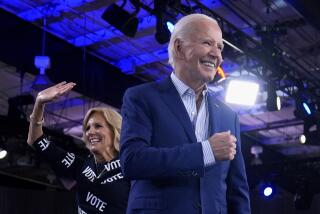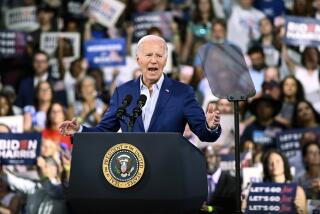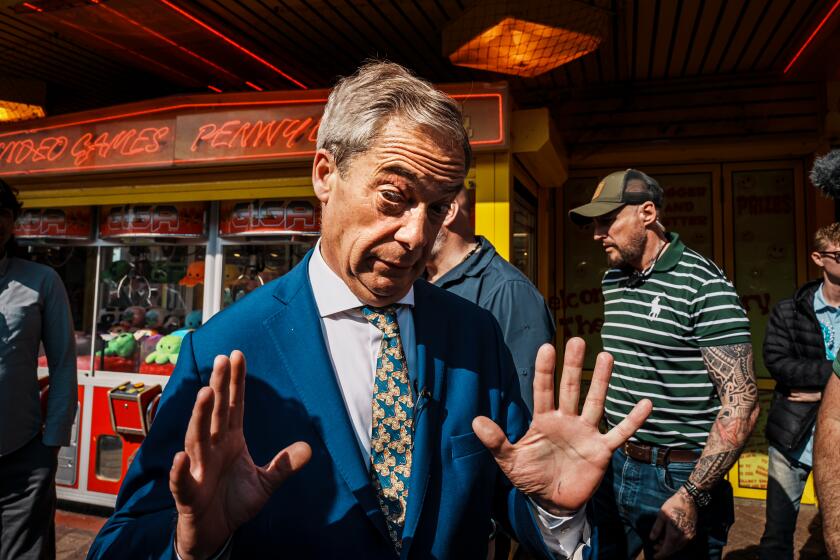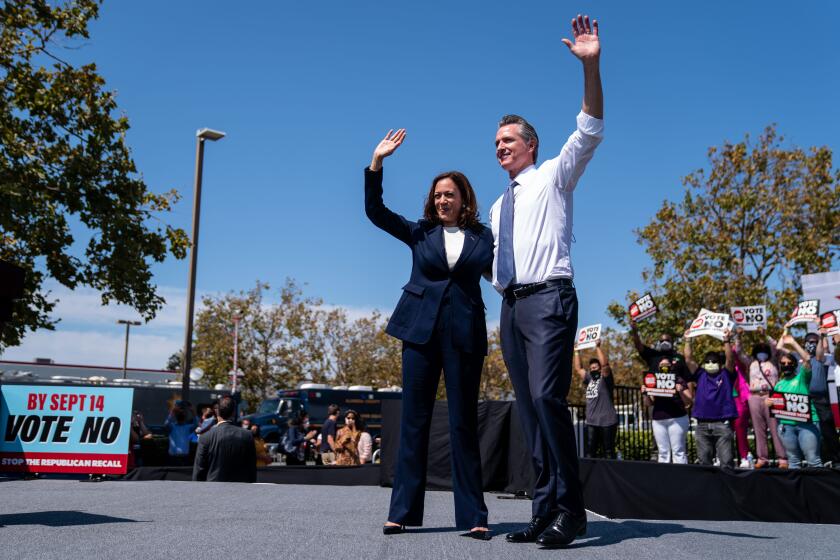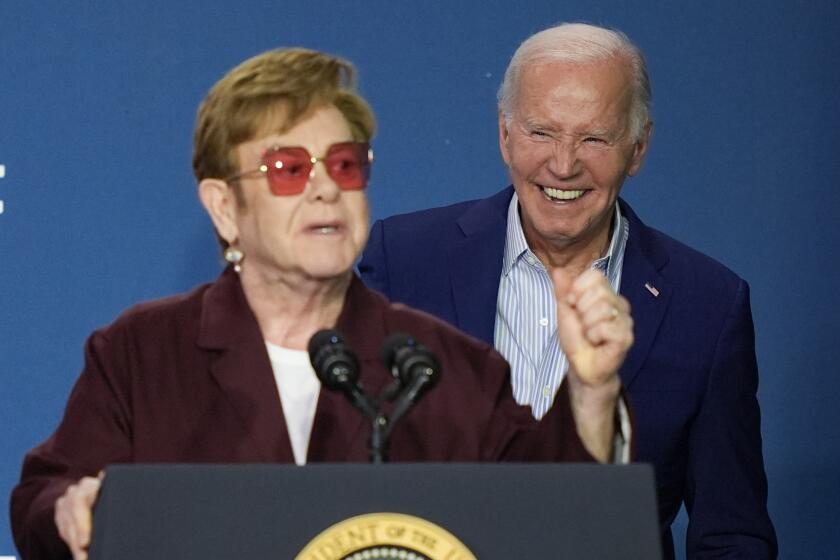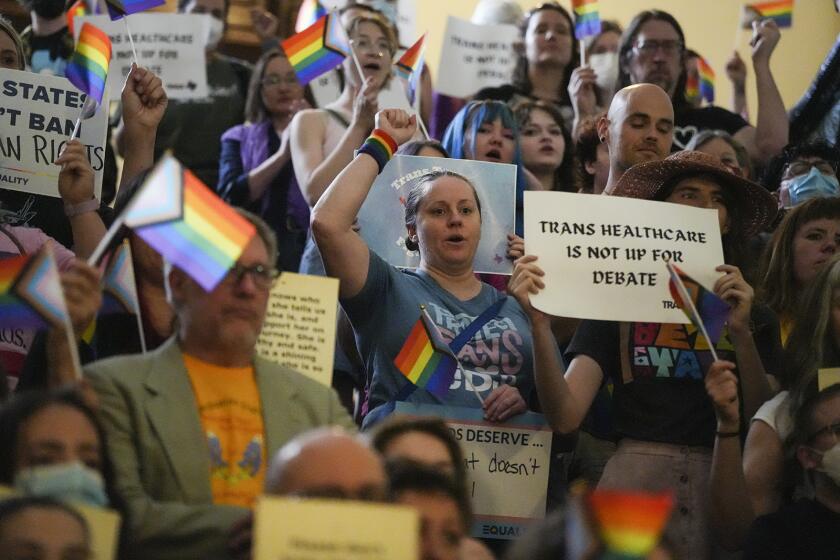Right Looks Win Votes, Study Shows
Americans choose their elected leaders, in part, the same way they buy vegetables--by appearance.
UC Irvine political science professor Shawn W. Rosenberg, who asked hundreds of subjects in the past year to rate--using only photographs--real and phony politicians on such characteristics as competence, trustworthiness, leadership ability and political demeanor, found that the best-looking, best-dressed candidates got much higher marks.
By manipulating appearances--changing hair styles, clothing and makeup--of six test candidates, Rosenberg found that he could push positive ratings up or down 20
percentage points. In a real election, the right looks could add 5% to 8% to a candidate’s vote total, enough to swing a close race, concluded Rosenberg and his research partner, Boston University economics professor Shulamit Kahn.
The manipulation study revealed that smiling, conservatively dressed politicians project a positive image. Rosenberg also uncovered a few quirks that he is at a loss to explain, such as a strong preference for one eye shape: a rounded upper eyelid with a straight lower lid, in contrast with eyes that do not curve on top or that curve equally on top and bottom.
And while baldness is bad politically, a widow’s peak hairline is regarded as a sign of competence, the study showed.
Rosenberg, who calls himself a political psychologist, set out to explore how Americans make sense of politics. He found that for most people, politics does not make sense.
Not Surprised
“I’m disturbed, yes, but surprised? No,” Rosenberg said. “The amount of attention we pay to politicians is really minimal, even during an election period, and the overall understanding of issues is quite rudimentary. As a result, we rely on often-superficial cues or pieces of information to direct our judgment of candidates and events.
“What people are doing is saying, ‘I don’t really understand politics, so let me look at this person and decide if this person is trustworthy and competent.’ But how you look is not necessarily who you are, because that can be manipulated so readily.”
The study focusing on manipulation of features and dress is the latest in a series of candidate-preference works by Rosenberg since 1984. It is expected to be published next year in the scholarly journal Political Psychology.
The appearance studies have drawn attention--and mixed reviews--from politicians and the strategists who often play a role in shaping the candidates’ public images.
“I hope we haven’t spent a lot of taxpayer money on these surveys,” said Assemblyman Richard Katz (D-Sylmar), who acted as a consultant in Christian F. (Rick) Thierbach’s unsuccessful Assembly race against Republican Curt Pringle of Garden Grove last year.
Study Discounted
Katz discounted the study, in part, because the mock candidates used by Rosenberg were unknown and presented without the context of a normal political campaign.
Appearance plays a role in political success, just as dressing appropriately for a job interview can help determine who gets a position, Katz agreed. And although he said that Thierbach’s strait-laced demeanor and perceived standoffishness hurt the campaign, he said that issues and party affiliation, particularly in Orange County, have more to do with winning votes than looks.
“You have to take (appearance) into account, but you can’t let it be the determining factor,” Katz said. “There is some truth to the notion that people get impressions based on how you hold your head, your body language, your dress. But I believe voters pay attention to the message.
“I tend to give voters a lot of credit,” Katz said, noting the myriad ballot measures that voters waded through last fall to overwhelmingly select one insurance reform measure over several others.
“People who live in ivory towers don’t understand voters.”
But Rep. Robert K. Dornan (R-Garden Grove), who was host for a cable TV talk show for seven years before entering politics, said good looks and professional attire are keys to political success.
“All things being equal, the candidate with the neatly combed or well-coiffed hair, the conservative dress and the professional demeanor will get elected,” he said.
Peculiar Dress
“Some congressmen get away with wearing some peculiar forms of dress--you look at them and think, ‘Maybe it was the issues there, maybe he’s a good old boy who fits his district.’ ”
Cowboy boots and avant-garde clothes would not go over well in Orange County or before national TV audiences, Dornan said: “I do so much television that I dress so I’m always ready. I wear dark suits, rep ties and light-blue Oxford shirts. It’s almost a uniform for me. The public expects people who handle money--people who are bankers, accountants, lawyers and elected officials--to dress in a way that conveys trust.”
Dornan, who often wears a beard when not on the campaign stump, said he has had the “fortitude” to sport whiskers just once--in 1986--while running for office.
Harvey Englander, a Newport Beach political consultant who has directed campaigns for both Democrats and Republicans during a 21-year career, said he has used Rosenberg’s findings and common sense to make over some of his candidates to enhance their election chances. But he does not consider such packaging a manipulation of voters.
“I’ve changed a candidate’s hair style, glasses and gone shopping with the candidate for new suits and ties,” he said. “My clients have a message to impart, and we want to create an atmosphere where that message is heard. I don’t think the public will follow the message if they don’t feel comfortable with the messenger.”
Not Too Good-Looking
Light-colored shirts and dark suits work well for TV but may not appeal to less formal voters in a rural district, Englander said. He also believes that candidates cannot be too good-looking.
“I’ve heard that the average elected legislator is more attractive than the average person,” he said. “I don’t know if that’s true. But I do know voters don’t go for people who are too slick--a George Hamilton look is not good for a candidate. There are no absolutes.”
Rosenberg, who has turned down offers to act as a paid image consultant to political candidates (whom he declines to name), said the emergence of TV has forever changed the face of politics.
Appearances have always played a role, but since the Kennedy-Nixon debate in 1960, looks have been highlighted. Sen. John F. Kennedy, who wore a dark suit and used theatrical makeup, was a dramatic visual contrast to his presidential campaign foe, Vice President Richard M. Nixon, who refused makeup to cover his 5 o’clock shadow, perspired profusely and looked gaunt and pale in a light-colored suit.
“Before television, the key to election was manipulating the political party structure,” Rosenberg said. “What you knew and who you knew and family connections were also important. With the advent of television politics, the content of what you have to say is much less important. The party machinery is less important.
“Visual impressions and image are far more important.”
To find out whether a candidate’s appearance projects an image of fitness for office and to what extent image affects voter preference, Rosenberg drew on family connections in the California film industry.
Use of Makeup Artist
“We used a makeup artist and a studio photographer,” he said. “We found out we could manipulate most of the things we’re talking about.”
Using six women, ages 19 to 65, Rosenberg rearranged hair, dress and background settings. Makeup made broad faces appear narrower, long faces broader and changed hairlines to add a widow’s peak or blur a natural peaked hairline.
Positive and negative photographs of the six candidates were then presented in phony campaign flyers as Republican and Democratic party nominees.
Regardless of party affiliation or issue positions, the candidates who rated highest on 29 appearance characteristics also consistently won the highest voter ratings.
Photographs of male candidates, including dozens of real congressmen and senators, were rated in a previous study, with similar results. Mature age--perhaps associated with wisdom by voters--was a plus for both men and women.
Despite his findings, Rosenberg would not advise a radical make-over or cosmetic surgery for political hopefuls. If the only object is winning, U.S. political life is diminished, he said.
“We’ve had plenty of successful politicians who would not conform to my notions of the best-looking,” he said. Senate Majority Whip Alan Cranston (D-Calif.) has overcome the potential negatives of his bald pate and thin build, Rosenberg said, and Sen. Paul Simon (D-Ill.) has turned his unfashionable bow ties into a trademark.
“Political skills and ideas still count for a lot,” Rosenberg said. “And half of the game is just getting to the point where the voting population can assess you. First you have to be a party nominee.”
TURNING THE BEST POLITICAL CHEEK UC Irvine political science professor Shawn W. Rosenberg found that by changing hair styles, clothing and makeup of test candidates in certain ways, it was possible to affect ratings by 20 percentage points. In a real election, Rosenberg contends, the right looks could add 5% to ‘% to a candidate’s vote total, enough to swing a close race.
POLITICALLY UNATTRACTIVE * hair combed over forehead * lipstick used to make lips appear fuller, no smile * no jacket or jewelry * makeup sued to make eyebrows appear thicker * busier background in photograph POLITICALLY ATTRACTIVE * strong curve in upper eyelid shape * hair combed off forehead, makeup used to create the appearance of a widow’s peak * thinner lips, smiling expression * conservative dress with dark jacket and tasteful jewelry * thinner eyebrows * broad face * mature appearance (age) * simple background for the photograph
POLITICALLY UNATTRACTIVE * hair combed over forehead * lipstick used to make lips appear fuller, no smile * makeup used to shade cheeks and make face appear thinner * makeup sued to make eyebrows appear thicker * no jacket or jewelry * busier background POLITICALLY ATTRACTIVE * good curve in the shape of the upper eyelid * hair combed across forehead * thinner lips, smiling expression * short hair * businesslike jacket with conservative jewelry * makeup sued to make face appear broader * simple background for the picture
Rosenberg rates real politicians:
Gov. George Deukmejian
very good eye shape, with strong curve on top
age, mature appearance is a big plus
dresses formally; rarely seen in casual clothes
strong jaw is a positive
thick lips are a slight negative
President
George Bush
good hairline with slight widow’s peak
smiles often, with added positive of thin lips
good eye shape with curved upper eyelid
age, mature appearance
long, narrow face is a negative
slightly bushy eyebrows are a negative
Lt. Governor
Leo T. McCarthy
good curve in upper eyelid
thin lips are a positive
slightly long hair makes him appear younger and is a negative
long, thin face is a negative
Irvine Mayor
Larry Agran
long hair combed down across forehead is a negative
youthful appearance is a negative
thin lips are a positive
eyebrows are thin, also a positive
Former U.N. Ambassador Jeane J. Kirkpatrick
good curve to upper eyelid
age, mature appearance
short hair is a positive, but bangs combed over forehead a negative
presents self formally, also a positive
lips are slightly thick, could be thinned with makeup
More to Read
Get the L.A. Times Politics newsletter
Deeply reported insights into legislation, politics and policy from Sacramento, Washington and beyond. In your inbox three times per week.
You may occasionally receive promotional content from the Los Angeles Times.
